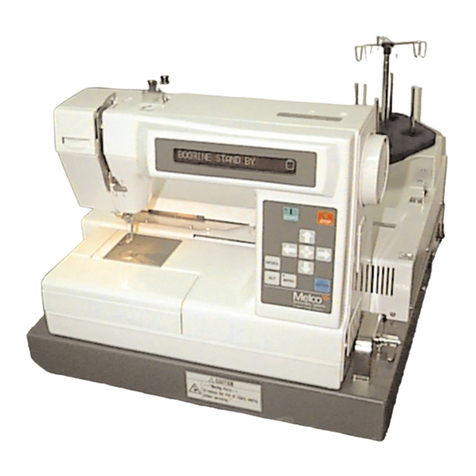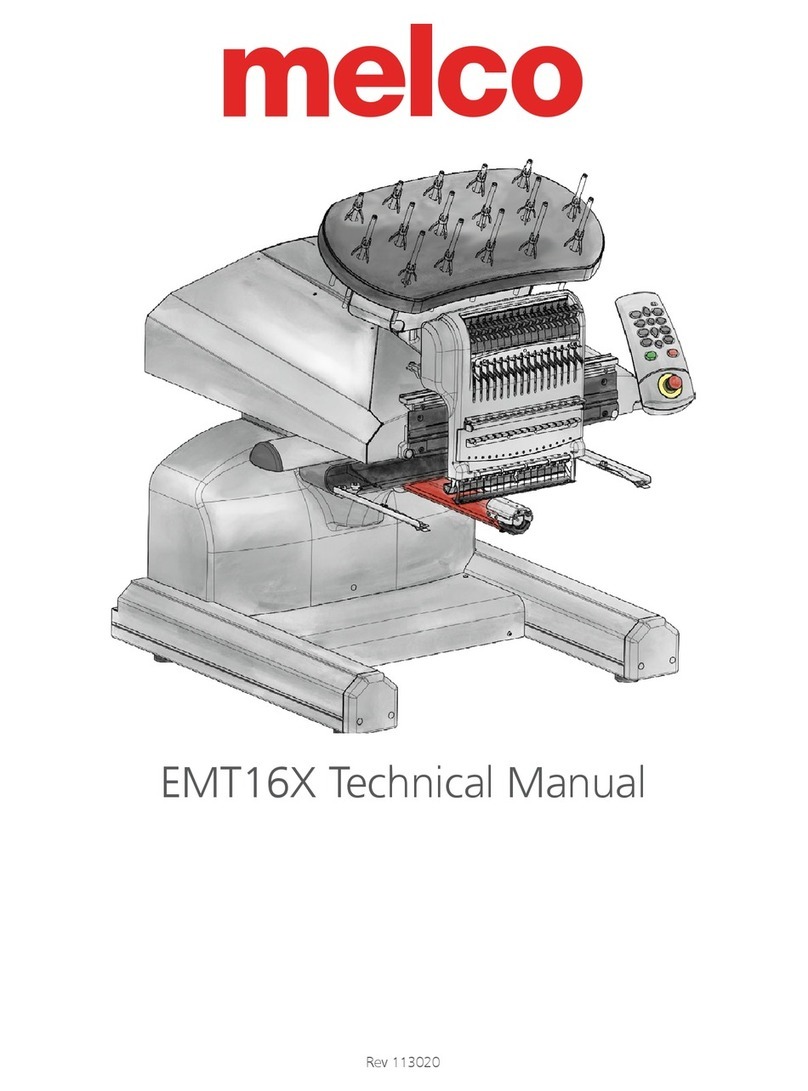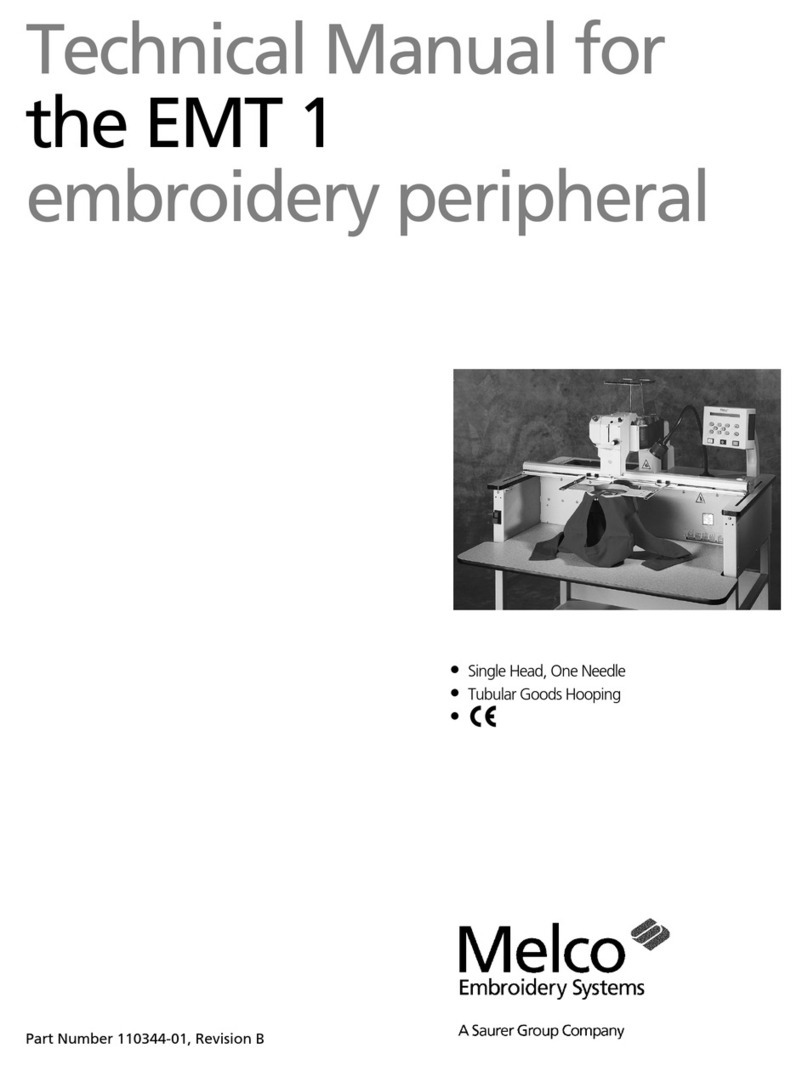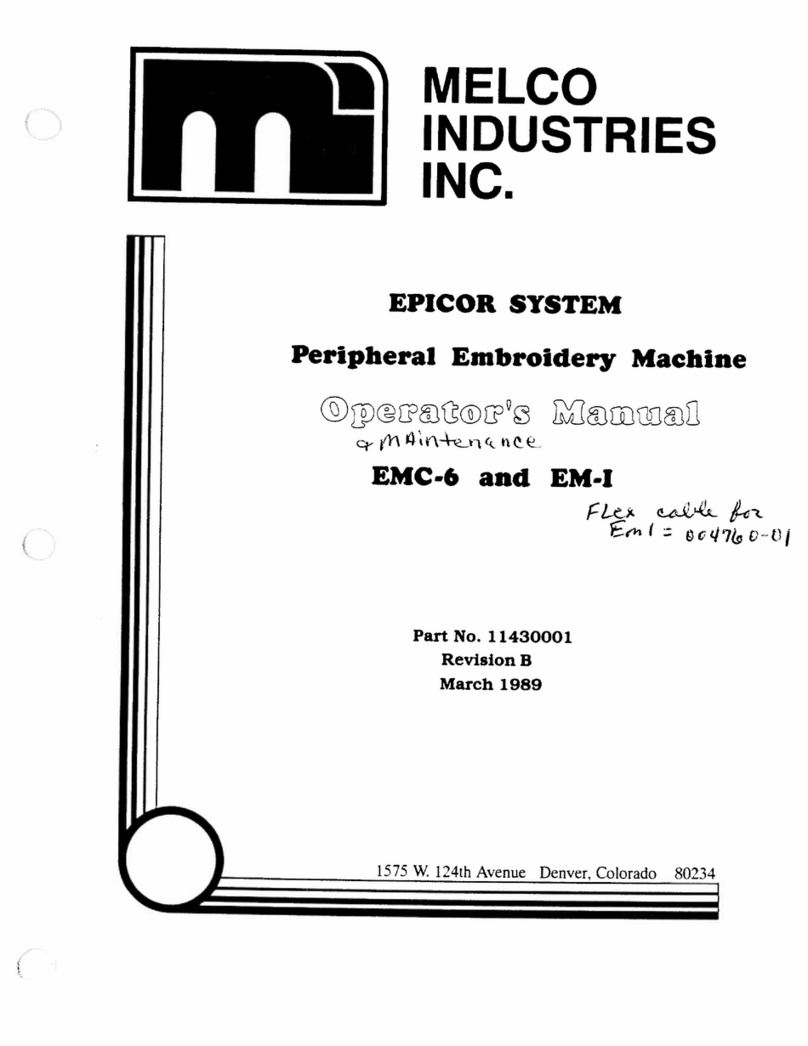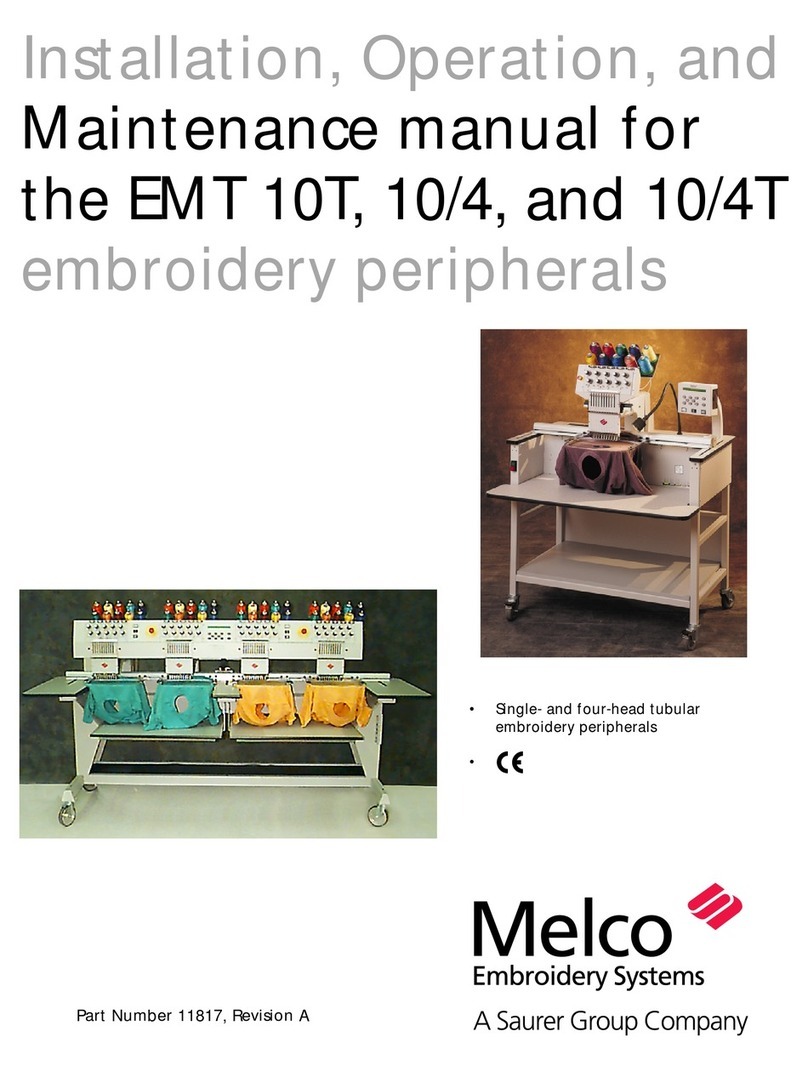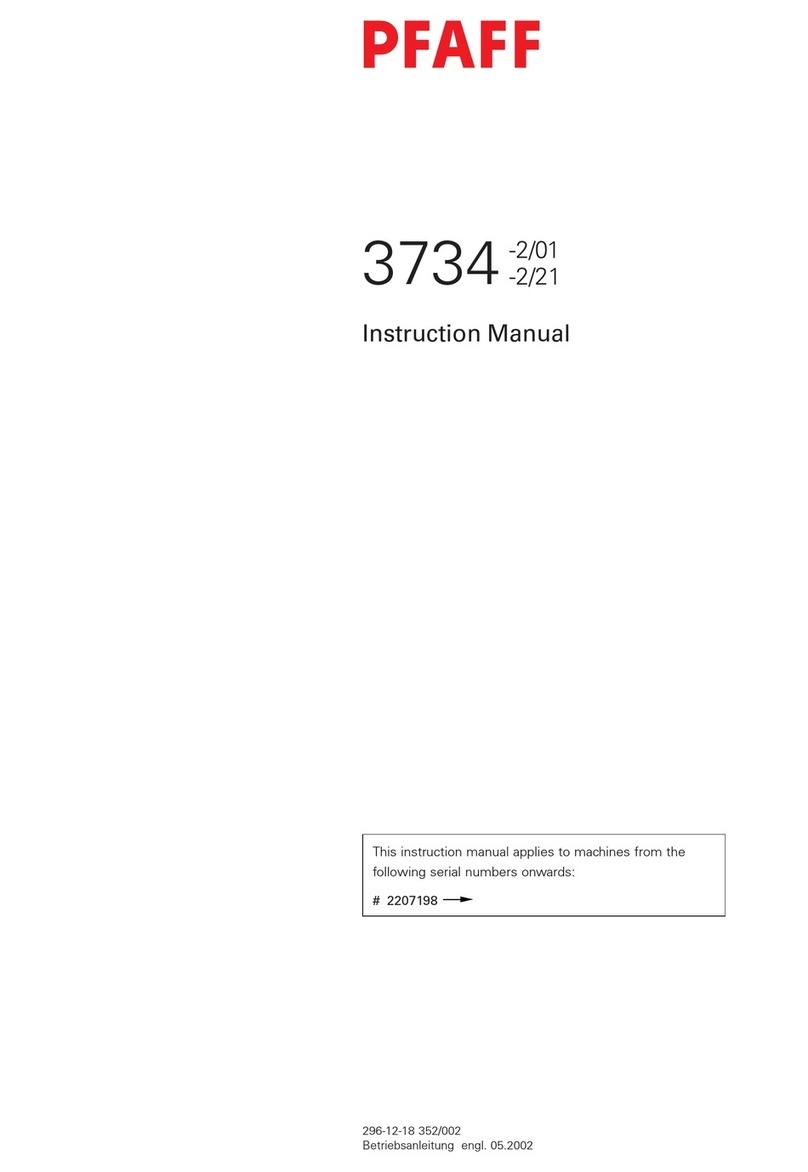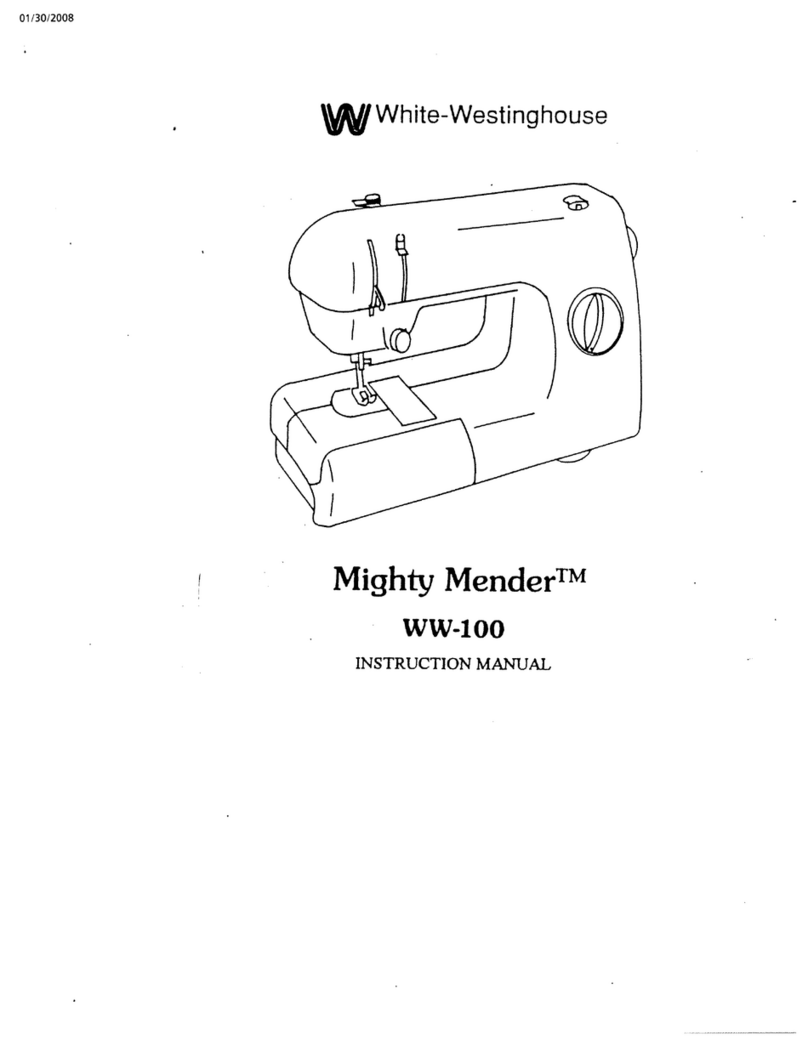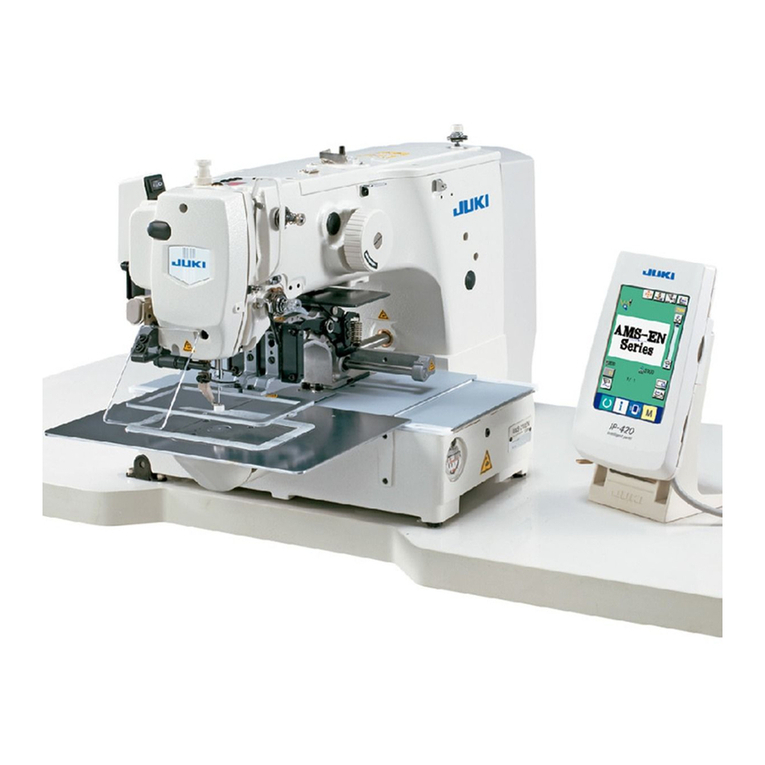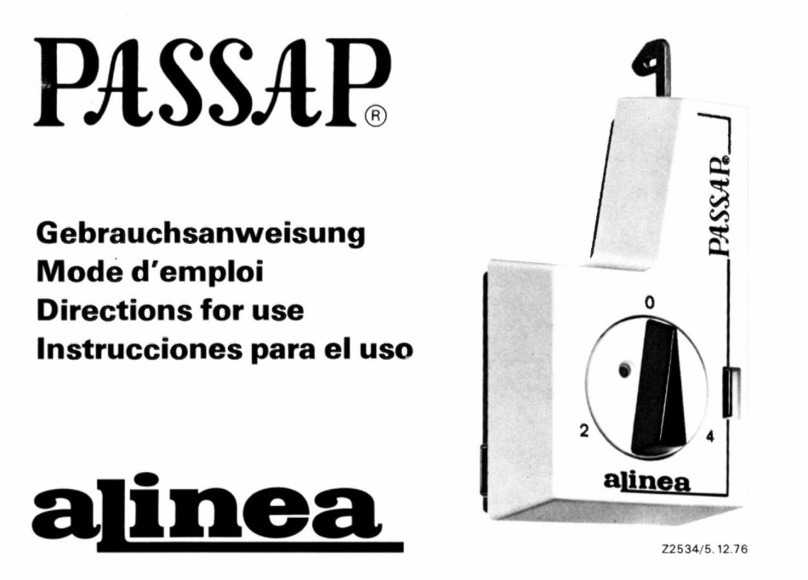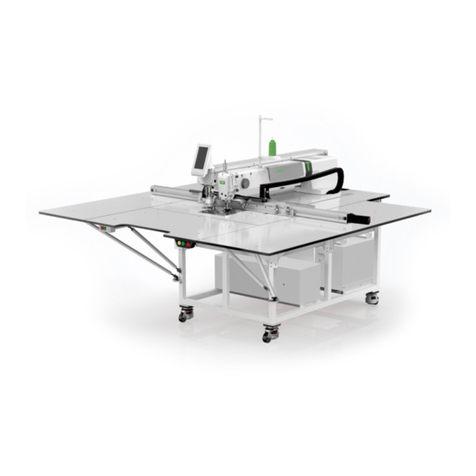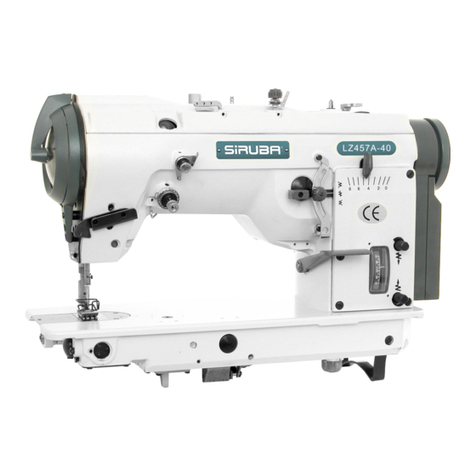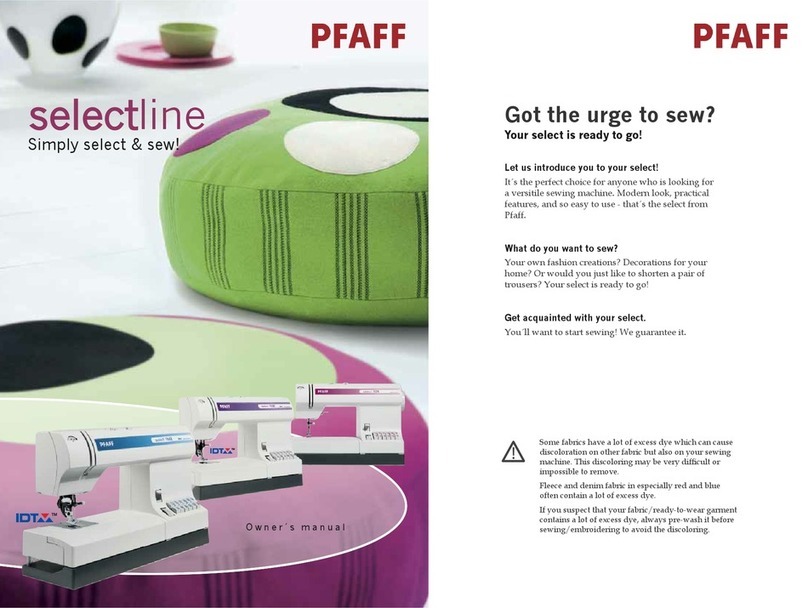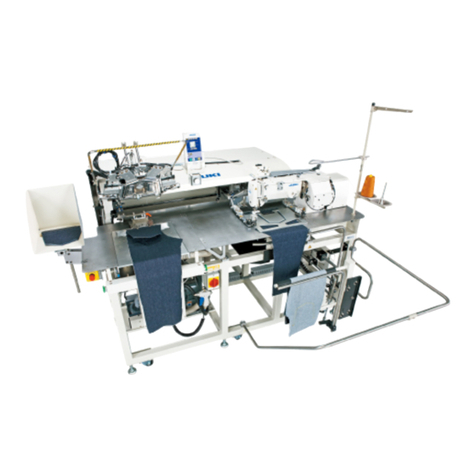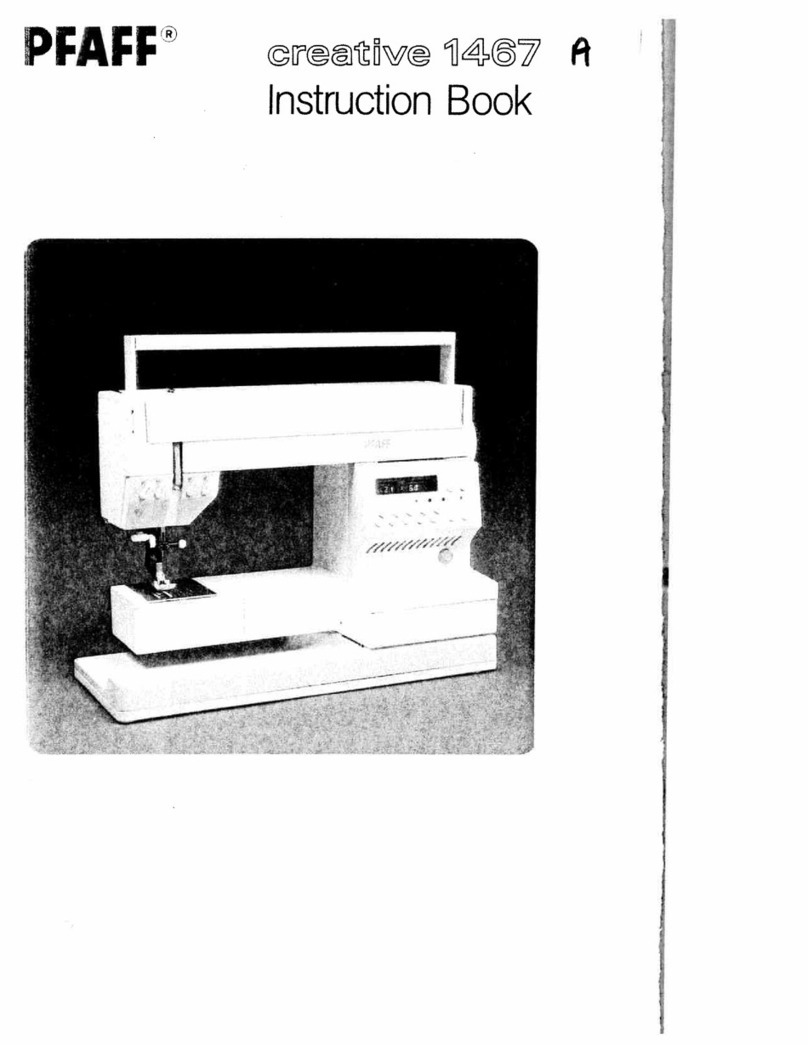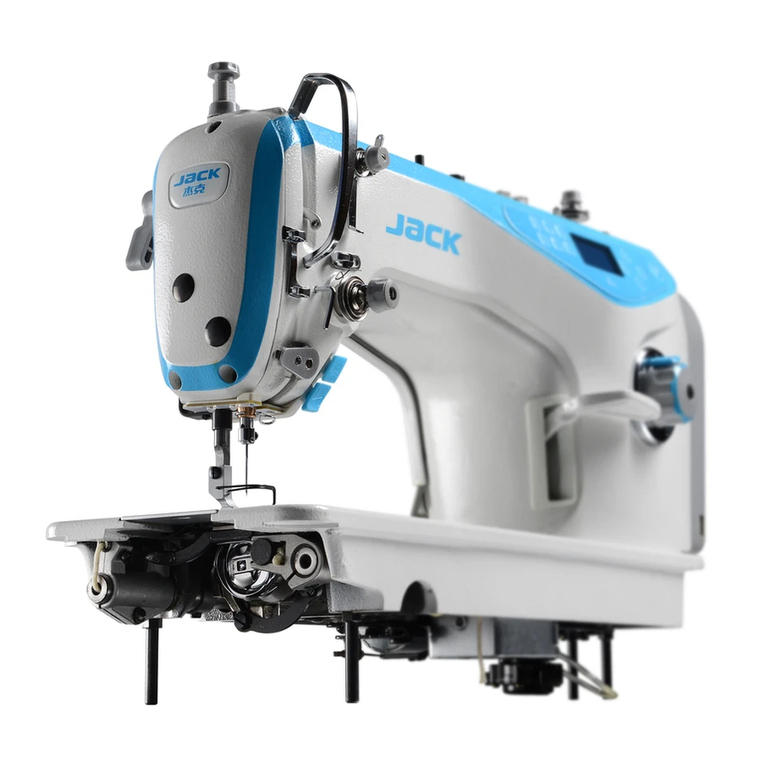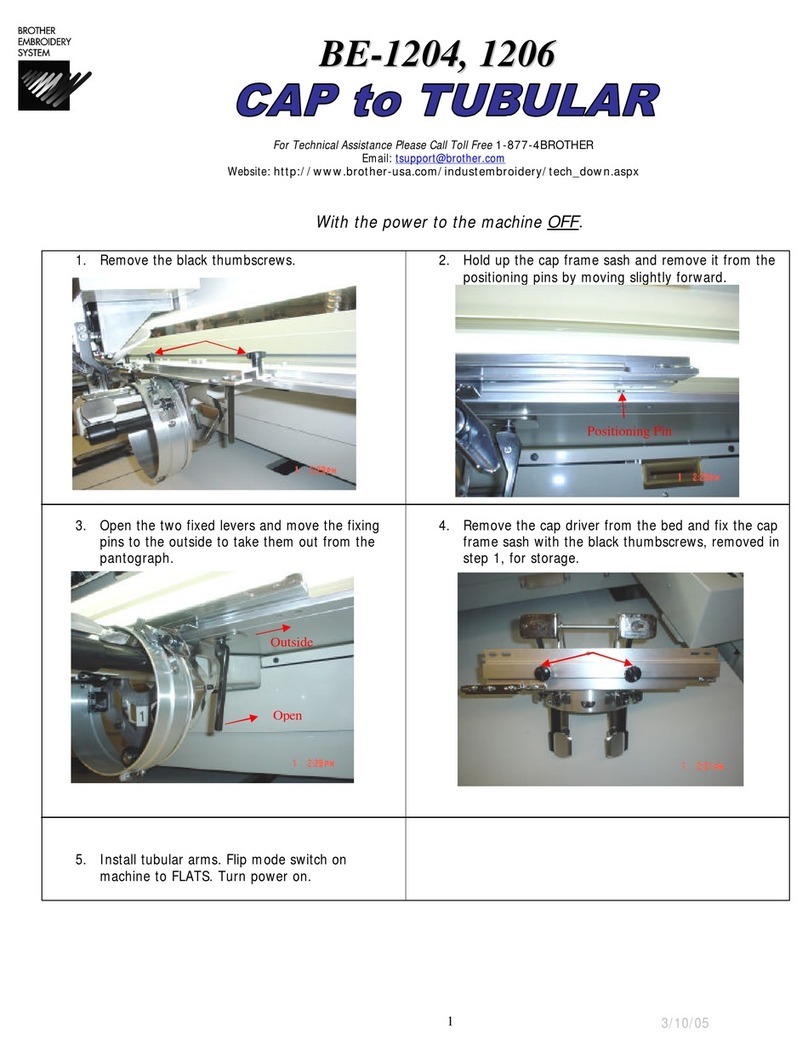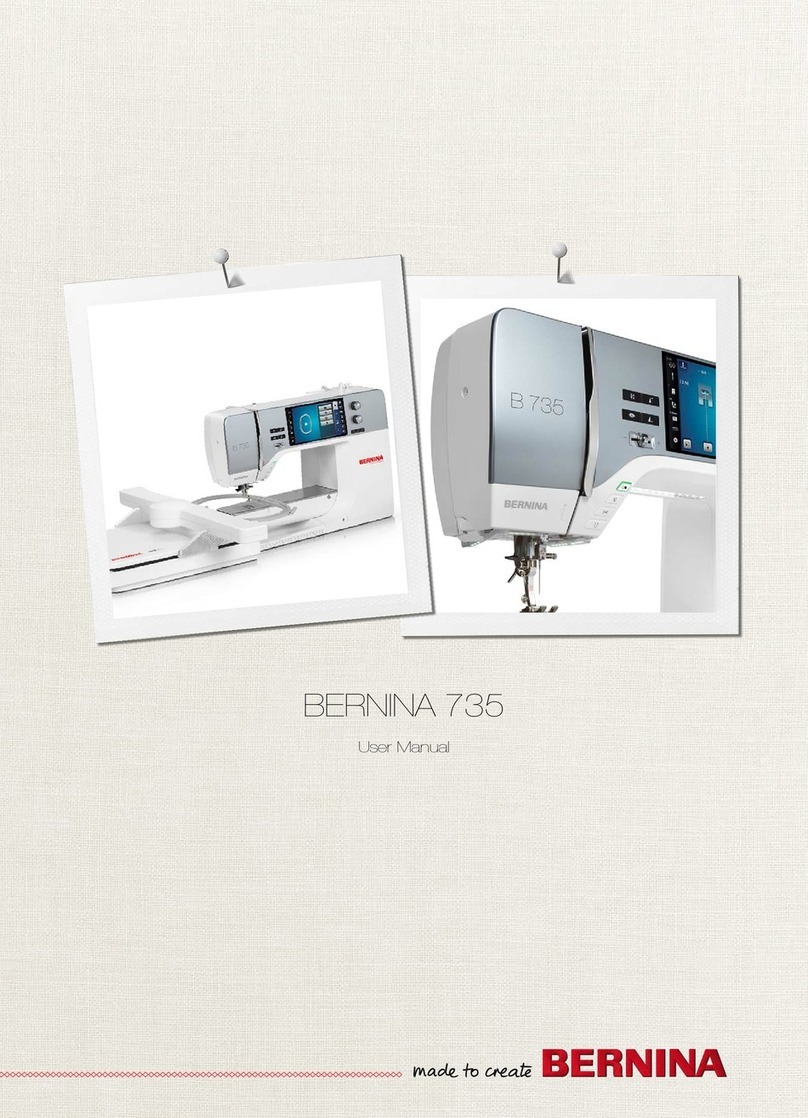Melco EP 1 User manual

Installation, Operation, and
Maintenance manual
for the EP 1
embroidery peripheral
• Single head, single needle
• Easy to operate
• Low power consumption
• High-quality results
Part Number 11034, Revision A

1575 West 124th Avenue
Denver, Colorado 80234
United States of America
© Copyright 1998 by Melco Embroidery Systems
ALL RIGHTS RESERVED No part of this publication may be reproduced, stored in a retrieval system,
or transmitted in any form or by any means (electronic, mechanical, photocopying, recording, or
otherwise) without prior written approval of Melco Embroidery Systems. Melco reserves the right
to revise this publication and to make changes in it at any time without obligation of Melco to
notify any person or organization of such revisions or changes.
All precautions have been taken to avoid errors or misrepresentations of facts, equipment, or
products. However, Melco does not assume any liability to any party for loss or damage caused by
errors or omissions.
Printed in the United States of America
Revision A, May 1998

Table of Contents
1. Setup
2. Needles, Bobbins, and Threads
Threading the EP1 2 - 1
Drawing Out the Bobbin Thread 2 - 3
The Bobbin Case 2 - 3
Removal 2 - 3
Winding Thread Onto The Bobbin Reel 2 - 4
Setting the Bobbin 2 - 4
Installation 2 - 5
Setting Thread Tensions 2 - 5
Upper Thread Tension 2 - 5
Bobbin Thread Tension 2 - 5
How to Select a Needle 2 - 6
Needle Replacement 2 - 6
3. Embroidery Hoops
Loading Garments 3 - 1
Round Hoops 3 - 1
Rectangular Hoops 3 - 1
Attaching The Hoop To The Pantagraph 3 - 2
4. Detailed Operation
The Control Panel 4 - 1
The Liquid Crystal Display (LCD) 4 - 1
Start Key 4 - 1
Stop Key 4 - 1
Arrow Keys 4 - 1
Hoop Center Key 4 - 1
Spool Key 4 - 1
Menu Key 4 - 1
Enter Key 4 - 1
Alt Key 4 - 2
The Light Emitting Diodes (LED) 4 - 2
The Operation Menus 4 - 2
Design Menu 4 - 2
Table of Contents
i

Run Design 4 - 2
Frame Menu 4 - 3
Trace Menu 4 - 3
Hoop Selection 4 - 3
Move Menu 4 - 3
Moving The Hoop Numerically 4 - 3
Seeing The Hoop’s Physical Location 4 - 3
Reset Menu 4 - 4
System Reset 4 - 4
Hard Reset 4 - 4
Other Functions 4 - 4
Thread Break 4 - 4
Bobbin Thread Low 4 - 4
Dust Accumulation 4 - 4
Upper Shaft Lock 4 - 4
Hoop Limits 4 - 4
5. Configuration
Unit Number 5 - 1
Display Brightness 5 - 1
Key Click Volume 5 - 2
Error Beep Volume 5 - 2
6. Operator Maintenance
Cleaning 6 - 1
Disassembling the Hook Area 6 - 1
Assembling the Hook Area 6 - 1
General Cleaning 6 - 2
Lubrication 6 - 2
Lubricating the Hook Area 6 - 2
General Lubrication 6 - 2
7. Troubleshooting Guide
Table of Contents
ii

iii
Single-Head Embroidery Peripheral
EP 1 Specifications
Maximum embroidery speed
1000 stitches per minute
Number of Heads
1
Number of needles
1
Dimensions
46cm W x 36cm H x 52cm D
18" W x 14" H x 20.5" D
Weight
26kg
58 lbs
Shipping weight
31kg
68 lbs
Power consumption
60 W; wired for 200V to 250V 50 or 60Hz
2 fuses, 800mA Fast Blow (FB)
Noise level and test conditions
Equivalent continuous A weighted sound pres-
sure level at 1 meter from the machine is 66db.
The peak C weighted instantaneous sound
pressure level is 71db.
The noise level was measured sewing a test
design at 600 spm.
Recommended power conditioning equip-
ment
LC 1800 Line stabilizer (available from
Accessory Resource Corporation)
Embroidering field size
24 x 14cm (9.5 x 5.5")
Compatibility
Premier, EDS-EZ, and EDS III
Intended use
The EP 1 is designed to embroider on textile
products which are placed easily in a Melco
embroidery hoop. The machine should not be
used on thick leather, wood, plastic, or other
dense material.

Table of Contents
iv
Explanation of Symbols
Caution!
Indicates a machine component will move. Keep clear!
Shock hazard. No user replaceable parts behind this label. Do not open!
Pinch point, Keep clear!
Pinch point, Keep clear!
Pinch points, Keep clear!
Needle pinch point, Keep clear!

1-1
1. Setup
The setup procedure for the EP 1 Embroidery Peripheral is easy and will only take a few minutes.
1. Carefully remove the machine from the shipping container, using care not to drop or damage
any other items packed around it. The machine is heavy, so be careful. Place the machine on a
sturdy table or work bench.
NOTE: Be sure to save the shipping container and packing supplies that your embroidery periph-
eral came in. If your machine should ever require factory service, it should be returned in
the original (or other equally suitable) shipping container.
2. Make certain the machine’s power switch is turned to the OFF position.
3. Plug one end of the power cord into a wall outlet. A
surge protector is recommended but not required.
Plug the other end into the machine.
4. Connect the peripheral to your controller or host
computer using the network cable. Plug the net-
work cable into either of the network ports, as
shown in Figure 1-1. Plug the terminator cable into
the other network connector. It does not matter
which cable is plugged into which connector.
5. Your machine may have come with a needle already
installed, but it is a good idea to start your sewing
with a new needle.
6. Locate the thread guide bar and gently pull it
upward until it reaches its maximum height. It will
extend like a car antenna. Rotate the guide bar until
the ends are aligned over the thread cones on the
base below (see Figure 1-2).
7. Your machine may have come with thread already
loaded on the bobbin, but check to make certain.
8. Load a spool of thread onto the thread stand and
thread the machine as required.
At this point your EP 1 should be ready to begin sewing.
If you should encounter any problems during this procedure, contact your local Melco representa-
tive for assistance, or call Melco’s Technical Support line.
11034 Rev. A 1. Setup
Figure 1-1
Network cable
Terminator cable
Figure 1-2

1-2
EP 1 Operation Manual Melco Embroidery Systems
Hazards of operation
Caution! Below are risk areas or danger points encountered dur-
ing operation. Always wear eye protection while operating the
machine to prevent injury in the event of a needle break. Do not
wear loose or baggy clothing when operating the machine.
Take-up Lever Oscillation
Do not touch the take-up levers during operation.
Exposed Needles During Operation
Do not place body parts or other foreign objects under the needles
during operation.
Rotary Hook Rotation
Do not attempt to change bobbin thread during operation. Do not
place hands or other objects in the rotary hook area during operation.
Do not operate the machine without the hook guards in place.

1-3
Dangers de service
Attention! Ci-dessous vous trouverez les descriptions de diverses zones
de risque ou points dangereux lors du service de la machine. Il faut tou-
jours porter des lunettes protectrices pendant le service de la machine
afin d'éviter des blessures en cas d'une casse d'aiguille.
11034 Rev. A 1. Setup
Oscillation du releveur de fil
Ne pas toucher les releveurs de fil pendant le service.
Aiguilles exposées pendant le service.
Ne mettre ni de parties du corps ni d'autres objets au-dessous
des aiguilles pendant le service.
Rotation de la navette rotative
Ne pas essayer de changer la canette pendant le service. Ne
pas mettre ni les mains ni d'autres objets dans la zone de la
navette rotative pendant le service. Ne pas mettre la machine
en marche sans avoir mis en place les gardes du ramasseur.

1-4
EP 1 Operation Manual Melco Embroidery Systems
Betriebsgefahren
Vorsicht! Nachfolgend sind Risikobereiche und Gefahrenpunkte genannt,
die während des Betriebs auftreten können. Tragen Sie immer einen
Augenschutz, wenn die Maschine in Betrieb ist, um Verletzungen im Falle
eines Nadelbruchs vorzubeugen. Tragen Sie keine weite oder lockere
Kleidung, wenn Sie die Maschine bedienen.
Hin- und Herbewegung des Fadengebers
Die Fadengeber nicht berühren, wenn die Maschine in Betrieb
ist.
Offenliegende Nadeln während des Betriebs
Körperteile fernhalten und keine fremden Gegenstände unter
die Nadeln legen, wenn die Maschine in Betrieb ist.
Umdrehung des Umlaufgreifers
Die Garnspule nicht austauschen, während die Maschine in
Betrieb ist. Die Hände vom Umlaufgreifer fernhalten oder
andere Gegenstände nicht in den Bereich des Umlaufgreifers
bringen, wenn die Maschine läuft. Die Maschine nicht bedi-
enen, wenn der Greiferschutz nicht an seinem Platz ist.

1-5
Pericoli nel funzionamento
Attenzione! Di sotto vengono descrite le zone di rischio o i punti peri-
colosi che potreste incontrare durante il funzionamento. Portate sempre
degli occhiali prottetivi mentre comandate la macchina, per pervenire il
ferimento in caso di rottura di ago.
11034 Rev. A 1. Setup
Oscillazione delle leve d'avvolgimento
Non toccate le leve durante il funzionamento
Aghi esposti durante il funzionamento
Non mettete delle parti del corpo o altri oggetti stranieri sotto
gli aghi durante il funzionamento.
Rotazione del perno girevole della bobina
Non provate a ricambiare la bobina di filo durante il funziona-
mento. Non mettete le mani o altri oggetti sul perno girevole
della bobina durante il funzionamento.

1-6
EP 1 Operation Manual Melco Embroidery Systems
Risco de funcionamento
Atenção! São a seguir indicadas áreas de risco ou zonas perigosas encon-
tradas durante o funcionamento. Usar sempre protecção para os olhos ao
comandar a máquina para evitar ferimentos no caso de quebra de agulhas.
Não use vestuário solto ou desapertado quando trabalhar com a máquina.
Oscilação da alavanca de enrolamento
Não toque nas alavancas de enrolamento durante o seu fun-
cionamento.
Agulhas à vista durante o funcionamento
Não coloque partes do corpo ou objectos estranhos por baixo
das agulhas durante o funcionamento.
Rotação do gancho rotativo
Não tente mudar fios das bobinas durante o funcionamento.
Não ponha as mãos ou outros objectos na área do gancho rota-
tivo durante o funcionamento. Não trabalhe com a máquina
sem os resguardos dos ganchos estarem instalados.

1-7
Peligros durante el funcionamiento
¡Atención! A continuación se mencionan las zonas de riesgo o los puntos
de peligro con los que se podrían encontrar Vds. durante la maniobra.
Utilicen siempre gafas protectoras cuando operen la máquina a fin de pre-
venir heridas en caso de rotura de la aguja. No lleven vestidos holgados
mientras están operando la máquina.
11034 Rev. A 1. Setup
Oscilación de la palanca de compensación (entrega-hilo)
Eviten tocar las palancas de compensación (entrega-hilo)
durante el funcionamiento.
Agujas al descubierto durante el funcionamiento
Eviten colocar partes del cuerpo u otros objetos debajo de las
agujas durante el funcionamiento.
Rotación del gancho giratorio
No traten de cambiar el hilo inferior de bobina durante la
operación. Eviten colocar las manos u otros objetos en la área
del gancho giratorio durante el funcionamiento. No accionen la
máquina sin el dispositivo de protección del gancho en su sitio.

1-8
EP 1 Operation Manual Melco Embroidery Systems

2-1
2. Needles, Bobbins, and Threads
This chapter covers how to thread your machine, select and install needles, wind the bobbin reels,
and properly set the upper and lower thread tensions.
Threading the EP 1
1. When routing the thread, apply a
small amount of pressure on the
supply spool to prevent the thread
from unwinding too quickly .
2. Hook the thread onto the thread
guide mounted above the supply
spool.
3. Pass the thread into the right hole
of the top plate thread guide from
the front to the back. Bring the
thread over the top of the same
thread guide and pass it into the left hole, again from the front to the back (refer to Figure 2-
1).
4. Hook it around the back of the tension disc (A) 1/2 turn in a counter-clockwise rotation (refer
to Figure 2-1). Use the rear tension disk (B) instead of (A) only when the Isacord thread is
used.
11034 Rev. A 2. Needles, Bobbins, and Threads
Figure 2-1
Threading
diagram
Thread
guide
Thread B
A
Figure 2-2
5. Pass the thread into the rear hole of the thread tension unit, with
the thread between the thin metal piece and the bar.
Figure 2-3
6. Pull the thread under the take-up spring and up the right side of
the thread tension unit, passing it under the take-up spring.

2-2
EP 1 Operation Manual Melco Embroidery Systems
Figure 2-4
7. Pass the thread through the embroidery
thread take-up lever from the left to the
right; and then pull it downward toward
the first lower thread guide.
Figure 2-5
Figure 2-6
8. Hook the thread into the two lower
thread guides as you continue to pull it
downward.
Figure 2-7
Figure 2-8
9. Hook the thread into the needle bar thread guide from the left
side.
Figure 2-9
10. Pass the thread into the needle from the front to the rear (use a
threader if desired).
Figure 2-10
11. After threading the needle, position the embroidery thread through
the presser foot hole. You may do this now by threading it as you
would the eye of a needle or in the following procedure while
drawing out the bobbin thread.

2-3
The Bobbin Case
Removal
1. After turning off the power switch, lift the needle
above the throat plate by rotating the flywheel.
2. Remove the auxiliary table by lifting slightly at its
left front and sliding it off to the left.
3. Open the bed cover by placing your finger at the
left rear of the cover and flipping it forward and
down to its opened position.
4. Pull out the bobbin case lever and remove the
bobbin case from
NOTE: The hook area must be kept clean to avoid
thread breakage problems! If you find any
thread debris at this time, clean it out.
Winding Thread Onto The Bobbin Reel
The bobbin winder can wind bobbin thread anytime, even while
embroidering, because the bobbin winder is an independent part of
the embroidery machine.
1. Attach the bobbin reel onto the bobbin winding shaft, and push
the bobbin winding shaft downward.
2. After hooking the bobbin thread onto the thread guide above the
bobbin thread cone, route the thread through the first thread
guide, and then the second guide, in this order. Each thread
guide features a thread path diagram, as shown in Figures 2-13
and 2-14.
3. Pass the thread through a bobbin reel hole from the inside
of the wall to the outside.
4. Press and hold the [SPOOL] key until the bobbin begins
turning.
NOTE: If the [SPOOL] key is not held down long enough, the
bobbin will not turn.
11034 Rev. A 2. Needles, Bobbins, and Threads
Figure 2-11
Figure 2-12
Figure 2-14
Figure 2-13

2-4
EP 1 Operation Manual Melco Embroidery Systems
5. After the thread has been wound completely, the bobbin reel will continue to spin for a few
moments before stopping.
6. After the bobbin reel has stopped turning, cut the thread and remove the bobbin reel from
the bobbin winding shaft.
7. If the thread was cut or if thread cannot be wound on the bobbin reel normally during thread
winding, the thread winding can be stopped by pressing the [SPOOL] key again.
Setting the Bobbin
After thread has been wound onto the bobbin reel and the bobbin reel is placed into the bobbin
case, install the bobbin case into the hook body.
NOTE: Turn the power switch OFF when putting the bobbin case into the hook body.
1. Hold the bobbin case in your left hand so the open side is facing toward you.
2. Hold the bobbin reel in your right hand.
NOTE: It is recommended that you orient the bobbin reel so the thread is coming off in a clock-
wise direction. However, some users feel that orienting it with the thread coming off in a
counter-clockwise direction is better. Either way is acceptable.
3. Place the bobbin reel into the bobbin case.
4. Grasp the end of the thread, and pass the thread into the bobbin case slit.
5. Draw the thread under the tension plate and out the opening in the bobbin case, then pass
the thread into the hole of the bobbin case horn (use the aid of the threader if desired).
6. Draw out the thread about 4 inches (10cm).
7. Set the bobbin thread tension.
Installation
1. To install the bobbin case into the hook body, pull out the bobbin case lever as you do when
you remove the bobbin case (the bobbin does not
fall out of the case when the lever is held out).
2. Position the bobbin case horn so it points
upward. Set the horn into the concave portion of
the hook body as you insert the bobbin case onto
the post in the middle of the hook body.
3. Release the bobbin case lever and check that the
lever has grasped the end of the post, thus secur-
ing the bobbin case in the hook body. Figure 2-15

2-5
Drawing Out the Bobbin Thread
After setting the bobbin thread and threading the embroidery thread, draw the bobbin thread out
of the needle plate hole as follows:
1. Hold the end of the embroidery thread by the left hand. Do not stretch it so tightly that the
needle tip is deflected.
2. Lower the needle once, and lift it again by rotating the flywheel toward you (counterclock-
wise) with your right hand.
3. After the embroidery thread take-up lever has reached the top, pull slightly on the embroidery
thread, and the bobbin thread will come through the needle plate hole.
4. Pull the drawn bobbin thread to the left, and hook it to the thread holder of the auxiliary
table.
5. Pull the embroidery thread loop to the left from below the Presser Foot, thus allowing it to
pass through the bottom hole.
6. Hook the embroidery thread to the thread holder on the left side of the faceplate. Take up any
looseness, and hang it down about 1 1/4 inches (3cm).
7. Use the face plate thread cutter to cut any surplus thread to a suitable length.Setting Thread
Tensions
Setting Thread Tensions
Upper Thread Tension
The upper thread tension wheel works best when set between 4 and 5 on the numbered dial. A
higher number on the dial will increase the tension and a lower number will decrease the tension.
Experimentation with different threads and fabrics will give you experience on how to set the
upper thread tension to best suit your needs.
Bobbin Thread Tension
For the best possible results, it is important to use the bobbin reels and bobbin thread that was
furnished with your machine. Most pre-wound bobbins do not work well with the EP 1. Melco
recommends the use of Rasant bobbin thread, which is available from Accessory Resource
Corporation.
1. Put the filled bobbin reel into the bobbin case. Make certain the thread goes through the slit
in the side of the case and under the tension plate.
2. Support the bobbin case with one hand and lift the thread with the other hand.
3. Dangle the case by the thread. The tension should be tight enough that the case is supported
by the thread. If the thread unwinds from the reel too easily, the tension must be increased.
Tighten the setscrew (clockwise) on the outside of the case.
11034 Rev. A 2. Needles, Bobbins, and Threads

2-6
EP 1 Operation Manual Melco Embroidery Systems
4. Gently jiggle the case like a yo-yo. The tension should be loose enough that a small amount of
thread (about an inch) unwinds from the reel, then stops. If no thread comes out, the tension
must be decreased. Loosen the setscrew slightly (counter-clockwise), then jiggle the case
again.
5. Once the tension has been set properly, put the thread through the hole in the horn that is
attached to the bobbin case, then install the case into the machine.
How to Select a Needle
The EP 1 embroidery machine uses a Class 15 household sewing machine needle. The following
needle types are given to help guide you in selecting the proper needle for your various embroi-
dering situations. This is only a suggestion, and you should choose your needles in the future
through experience you gain while embroidering.
HA x 1 65/9 sharp: for embroidering a thin material, like a pocket in the lining of a coat.
HA x 1 75/11 sharp: standard, applicable to almost all embroidering.
HA x 1 90/14 sharp: for embroidering a thick material, like a canvas bag.
65/9 ball point, 75/11 ball point, & 90/14 ball point: for knits, sweaters, & other delicate gar-
ments.
Needle Replacement
1. With the power switch turned OFF, raise the needle above the needle plate by turning the fly-
wheel counter-clockwise.
2. Loosen the needle clamp screw with a screwdriver.
3. Remove the needle by pulling it down and out of the needle clamp.
4. Check the new needle for a flat portion on the shank. If there is a flat, rotate the needle so
the flat is facing to the rear of the machine. This automatically positions the needle properly
for installation. If no flat is on the shank of the new needle you must orient the needle with
the “scarf’ facing to the rear of the machine. This will leave the ”thread groove" of the needle
in the front. (You can easily feel the groove by rubbing your finger nail across the front of the
needle.)
5. Insert the new needle fully into the needle clamp until it touches the pin.
6. Tighten the needle clamp screw securely.
Table of contents
Other Melco Sewing Machine manuals

